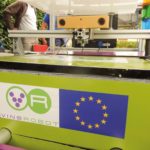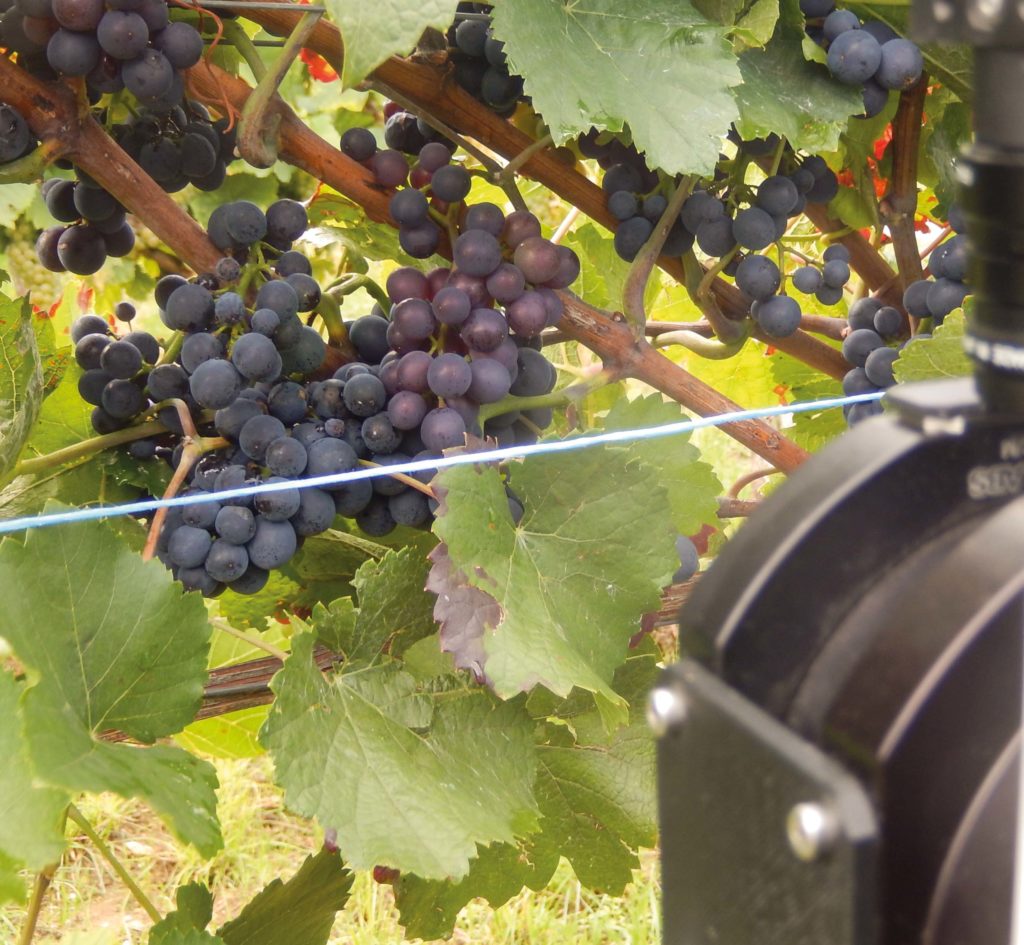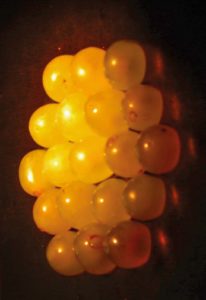The development of sensors in the field, as well as data processing, proceeds very quickly, and, in the near future, viticulture will see many innovations in terms of tools and applications. one of these is already in progress.
by Maria Luisa Doldi
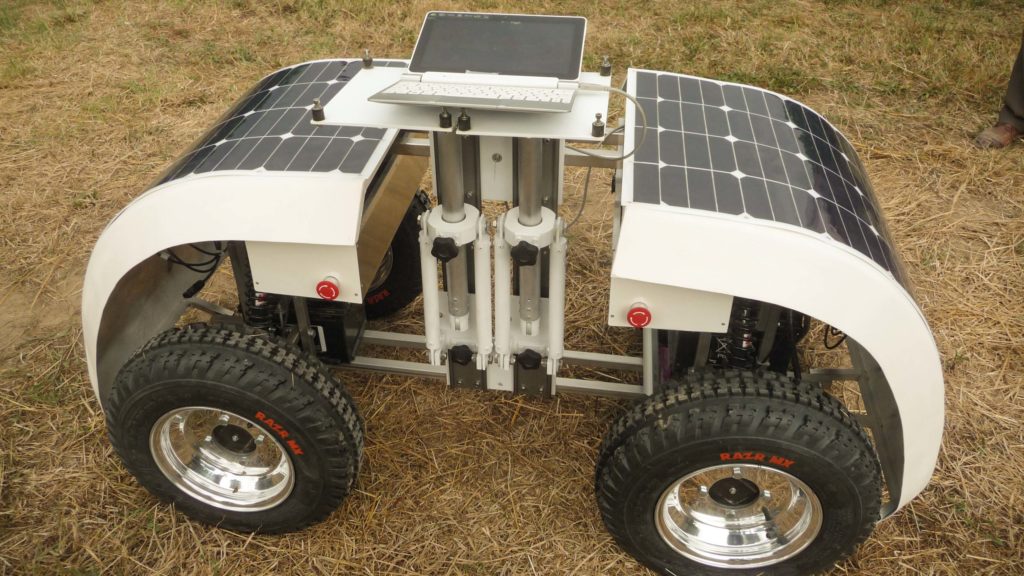
VineRobot is a small terrestrial robot, self-propelled, powered by a photovoltaic system on board, able to move autonomously in the vineyard.
Modern viticulture has to take daily decisions that are generally based on knowledge, experience and direct observations in the vineyard. However, the changes that the sector is going through require updates in the practices. Doing this on the basis of accurate, timely and correct information, allows the winemaker to manage the vineyard in a more effective, efficient and sustainable way. The use of sensors capable of continuously and simultaneously monitoring different parameters in the vineyard is certainly a great help for the winemaker and allows a much more detailed and precise analysis than the “manual” observation allows.
Alone through the vineyard
VineRobot is a small terrestrial robot, self-propelled, powered by an on-board photovoltaic system, which does not require a crew and is able to move independently in the vineyard. It was developed thanks to a European project in which 8 partners participated, including Italy. As the project partners explain, this small robot brings on board several non-invasive technologies for the detection of a series of parameters in the vineyard. Its purpose is the complete monitor of the vineyard in real time.
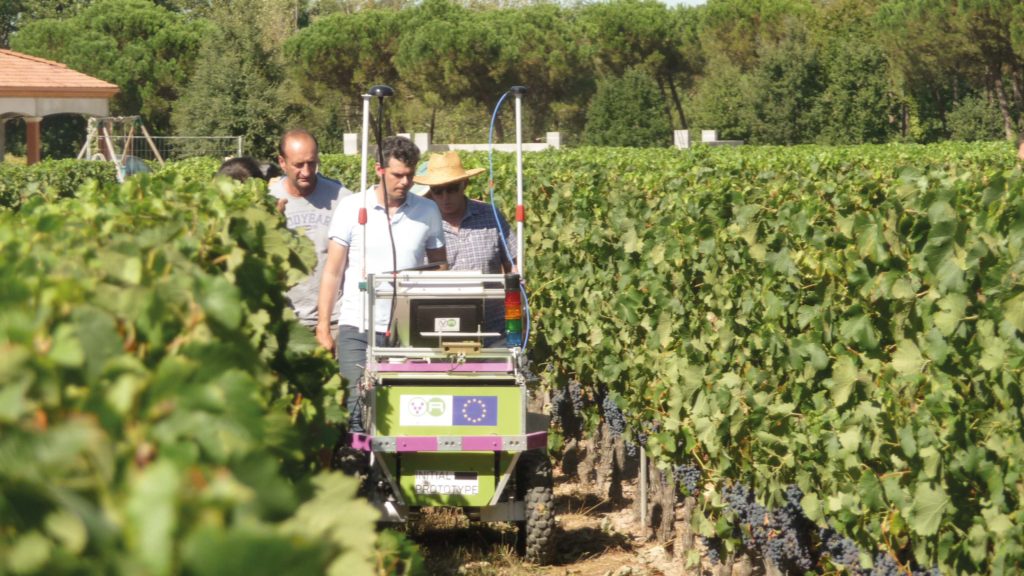
The design of the robot adapts well to the environment of the vineyard, where it can move easily between the rows.
Parameters such as vegetative growth, plant water situation, grape composition, are detected by sensors placed on the robots. Among these, fluorescent sensors to monitor the nitrogen of the leaves, sensors to detect the water stress of plants and sensors to detect the anthocyanins, both in order to distinguish the leaves from the fruits, and in order to build a map of grape ripeness. These data, processed by artificial intelligence systems, provide useful information to winemakers. GPS navigation allows robots to move easily between rows of vineyards, under safe and secure conditions.
[su_box title=”VineRobot
Project and partner” box_color=”#43634b”]
The project involves 8 partners (5 PMI e 3 research organizations) from 4 different European countries with viticulture and winemaking traditions (France, Germany, Italy and Spain). It was founded by the European Union Seventh program for research, technological development and demonstration. [/su_box]
Who benefits from it?
The use of sensors in the field to monitor different parameters, also related to plant health, is not new. There are several companies that in their portfolio offer vineyard monitoring and organization of the data collected in decision support tools for the winemaker. What’s new with VineRobot then? First of all, the structure: the robot can move continuously in the vineyard, at any time, in any condition without involving the need for human presence. It is much lighter than a tractor and uses much less, moving more easily between the rows, in a non-invasive way for the soil.
Compared to simple portable sampling devices, VineRobot can provide key information about the parameters of the vineyards much faster and at a higher resolution. It also works more flexibly and with lower costs than, for example, the technology of scouting from above carried out by drones or aircrafts. Carrying many sensors, it can record more data simultaneously, from which end users will receive updated information on the status of their vineyard through an application (mobile, tablet, computer).
The project partners state that the proposed robot will enable a revolutionary and decisive decision-making process to optimize vineyard management and support fundamental agronomic decisions. This based on the estimated yield of grapes, the plant growth monitoring, the water status, and the evaluation of the composition of the berries. Moreover: the sensors evaluation of the degree of ripeness of the berries and their quality, today is not yet present in the portfolio of companies that offer decision support systems. In the VineRobot project, on the other hand, sensors able to monitor these parameters are also being perfected, opening the way to the possibility of making a separate grape harvest based on the quality of the grapes, and, therefore, on the different processing to which they could be subjected in cellar.
[su_box title=”The VineRobot work process” box_color=”#43634b”]The robot monitors the parameters of the vineyard in real time: water status, quantity and composition of the grapes, plant growth; the images and data collected are processed and sent to the winemakers in a useful format; the final user receives real-time data from the vineyard through applications specifically developed for smartphones, tablet, etc.; these data can be used by the winemaker to decide how to manage the vineyard.[/su_box]
From prototype to reality
VineRobot promises a lot to modern viticulture, but how far are we from its actual application in the vineyard? According to project partners, from the point of view of data collection, the developments are very advanced. On the contrary there are some elements to be perfected as far as the vehicle mobility is concerned. Some demonstrations in the field pointed out that the design of the robot is well suited to the vineyard environment where it was tested.
Frame, transmission, suspension, steering, dimensions and weight make up a robotic platform that moves excellently in the vineyards.
Tests have shown that navigation within the rows of wine is very stable and accurate, but headland rotation still requires work to ensure a 100% success rate. Moreover, power supply management must be improved. In a new project a main control algorithm is planned that will constantly allow the knowledge of the robot power supply resources. On the whole, the key features of VineRobot have been positively evaluated, so the construction of the final version can start from the current prototype, improving the weak points and giving the robot a more attractive appearance from a commercial point of view. There are also issues of integration with the machines that normally work in the vineyard, for example mechanical harvesters. Today, this integration is not yet possible, but it is conceivable to be able to achieve it in order to separate the different kinds of grapes during the harvest, so that they could thus arrive in the cellar separately and be subjected to diversified treatments.
The future of viticulture? Impossible without 4.0
The remarkable development of new technologies and the growing demand for greater competitiveness and sustainability have led to a great interest in precision viticulture that promotes a differentiated agronomic approach to vineyard management, based on the space-time variability of plant growth, production and quality of the vineyards.
“The practice of viticulture requires first and foremost an objective and continuous monitoring of key parameters to support a rational decision-making process. However, we would like to emphasize that these technologies will not relieve human work and will never replace the experience and know-how of the winemaker but will be an important addition.
We believe that sensors are fundamental as a tool to support sound, correct and rational decisions”, the project partners say.
Not only. The vine is a multi-year plant. These tests provide a representation of the vineyard in its physiological details year after year and can therefore provide valuable information on how the vineyard evolves, on its state of health over the years, and finally constitute a real historical archive to understand how vines truly evolve over time. It is all information that a manual analysis could never give with the same precision and accuracy.

